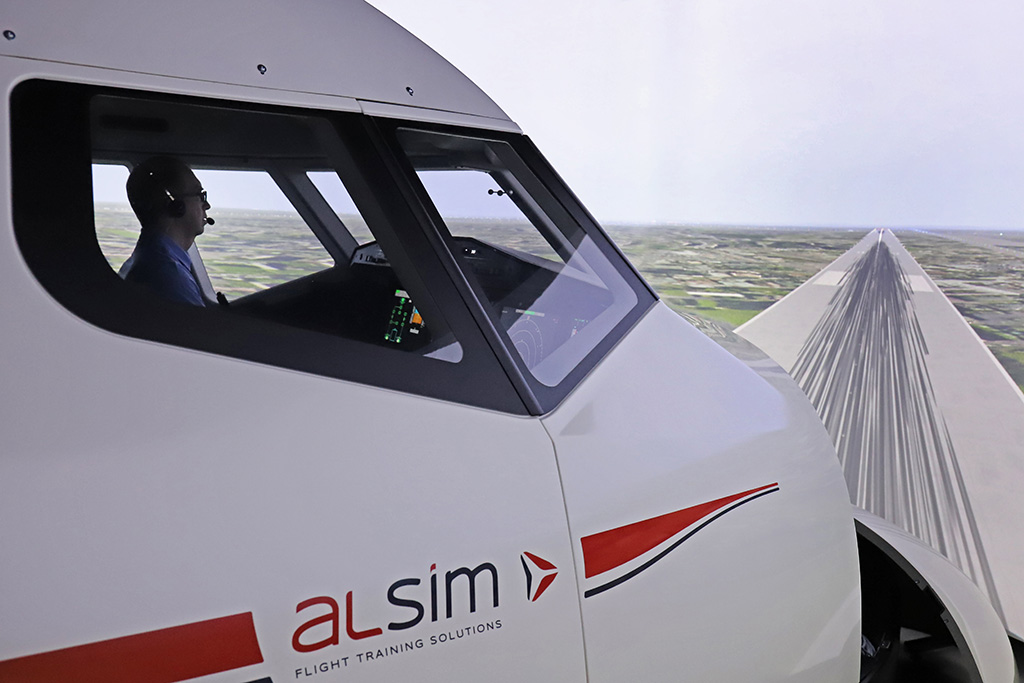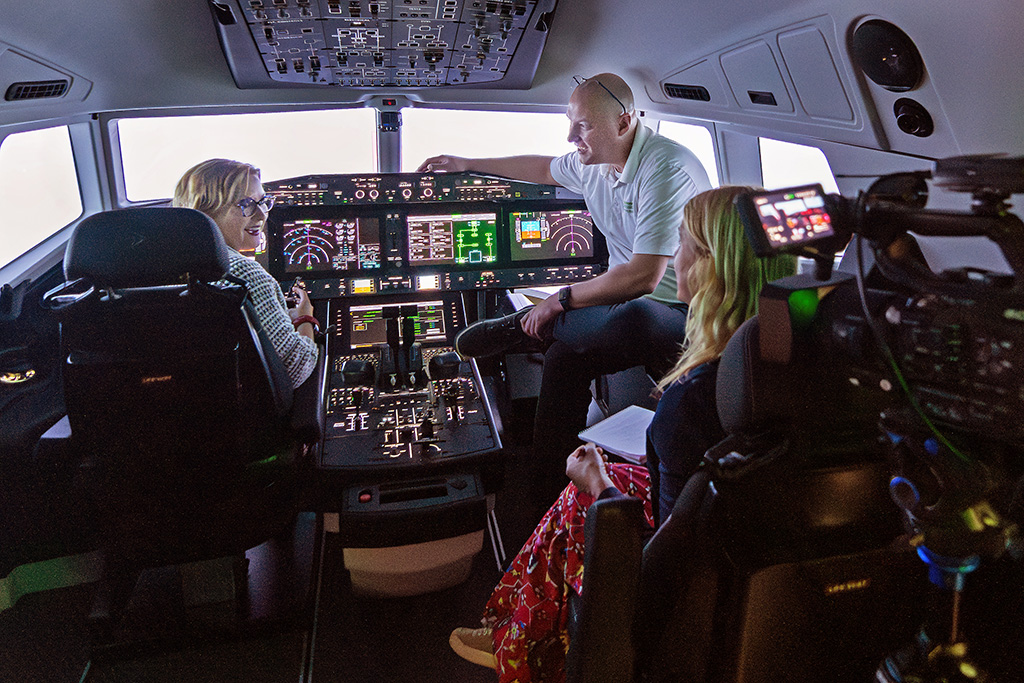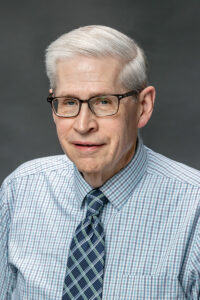Confessions of a flight simulator pilot
Washington Post visits UND to explore complexities of landing an airliner

There I was, in the clouds 20,000 feet above Minnesota, sitting behind the simulated controls of an Airbus A320 jet airliner with the pilot and co-pilot hypothetically incapacitated as potentially dozens of virtual passengers relied on my flying skills to return them safely to earth.
Would it help that I’d spent untold hours flying a World War II fighter on a personal computer flight sim? Did it make a difference that I had experience flying as a passenger in aircraft ranging from a single-engine, two-seat Piper Cub to a monstrous U.S. Air Force B-52 bomber?
What about the cloud seeding and weather research missions in which I’d participated? How about the Civil Air Patrol flight training I’d received as a high school student more than 50 years ago?
With my right hand on the throttles, my left hand on a joystick-like controller and my feet planted firmly on the rudder pedals, I had hopes that all this might count for something.
Watch this!
Behind me and to my right in the co-pilot’s seat was Andrea Sachs, a reporter for the Washington Post who made the trip from Washington, D.C., to UND’s John D. Odegard School of Aerospace Sciences. She was exploring the question of whether the average person could land an airliner in an emergency. I was one of four volunteer non-pilots and two pilots participating in the exercise, and the first of the group to fly.

Closely monitoring the situation were Brett Venhuizen, aviation department chair; Nick Wilson, associate aviation professor; and Matt Opsahl, assistant chief instructor who runs the school’s flight simulators. Opsahl served as a mock air traffic controller, while Wilson played the role of an airborne airline pilot attempting to assist me.
After about 45 minutes, the trio of aviation experts weren’t too impressed with my strategy of flying aimlessly about – as the airplane porpoised up and down – until I figured out how to navigate to an airport and land. After all, it could have taken five hours for the plane’s fuel to run out, and at the rate I was learning to fly, that was the most likely outcome.
Instead, they put my aircraft on final approach to the Minneapolis airport with the landing gear down. All I had to do was guide the plane to the runway, throttle back on the power, touch down and stop.
But, as frequently occurred during my computer flight sim exploits, I botched the landing by veering off the runway at nearly 70 mph, probably tearing off the plane’s landing gear and engines in the process.
The good news?
“He did a great job, but it was with a lot of guidance from us as instructors,” Opsahl observed. “We landed on the runway; we just exited it. We wouldn’t have died.”
The story begins
The impetus for this exercise began last March when Sachs wrote a story for the Post about the results of a poll in which people were asked about their level of confidence in landing an airplane in an emergency. Nearly a third had some confidence or high confidence they could land an airliner with some help.
Sachs reached out to aviation experts to get their take on whether someone with no flight training had any hope of safely landing an airliner.
Venhuizen was among those who agreed that the chance of a successful landing under the highly unlikely circumstances envisioned were at or near zero. Sachs ended her article by quoting him saying the best way to test the theory was to put non-pilots in an airliner flight simulator to see how they fared.
“Andrea contacted me a couple of weeks after that article went out because it was well received,” he said. “They wanted to come out, find folks with various experience levels and try this.”
Thus, Sachs and Luis Velarde, the Washington Post’s national video editor, came to Grand Forks to spend the better part of two days in the school’s ALSIM jet airliner simulator on which UND’s commercial aviation students train. It’s a state-of-the-art flight simulator representing the cockpit of an Airbus A320, although it can be configured to simulate other airliners.

The two pilots involved aced the exam. They were Dr. Aaron Prestbo from Sioux Falls, S.D., a private pilot with some instrument training, and Brian Dilse, an experienced airline pilot and aviation instructor at UND.
Interestingly, neither of the real pilots said they would have felt comfortable stepping into this hypothetical scenario. A pilot with more training and experience on an Airbus A320 would be the best-qualified pilot to handle the situation, they agreed.
A professional touch
“Brian is a very experienced professional aviator, and thankfully we have him on our faculty here to train the next generation of aviation professionals,” Wilson said. “He landed the aircraft successfully. Honestly, it was a relatively boring sequence of events. He did all the things you’d expect a professional aviator to do.
“With the other individuals who had no pilot training, there was a lot more variation in their outcomes,” he added. “That’s not surprising when you think about what we do with high-level pilot training, reducing variation so that everyone performs at a high level all the time.”
The second non-pilot to fly the simulator was Meloney Linder, UND’s vice president for Marketing & Communications. She made the fatal error of turning off the plane’s autopilot and sending the plane plunging into the ground. However, once lined up on the runway at the Minneapolis airport, she made a good landing with coaching from Wilson and Opsahl.
“The UND team decided they wanted this to be a positive experience for the participants,” Venhuizen noted. “To accomplish this, they decided that once it became clear that the volunteers had gotten themselves into a situation where there would be a poor outcome, they stopped the simulation. The participants were then offered the opportunity to ‘land’ the plane with guidance and instruction from final approach through touchdown.”

UND finance major Bretton Daku, who took a turn in the flight simulator after completing his freshman year finals, suffered the same fate as Linder when he turned off the autopilot and put the aircraft into an unrecoverable dive.
“Just being put in that situation tends to get really stressful and probably is meant to be that stressful,” he commented. “I think I was more prepared for finals. I wasn’t really too prepared for this, but it was a good experience.”
What goes up
Alexa Vilven, an accountant in the aerospace school, showed great skill in guiding the airliner to the Minneapolis airport. She just couldn’t bring herself to land the plane on the runway, saying she would have preferred a water landing in nearby Lake Minnetonka.
Opsahl noted that all four non-pilots exhibited a similar tendency.
“The non-pilots want to go up, which makes sense because down is where the danger is,” he said. “You have this kind of subconsciousness that makes you want to go up and not come down.”

Sachs, who spent time in the flight simulator with Wilson in the co-pilot seat, also was talked through the process of conducting a successful landing. She toured UND’s flight training facility at the Grand Forks International Airport, leaving her with a better sense of what airline pilots do and the level of training they receive.
“I had a little sense of what the simulator was, but I didn’t realize that it really simulated the flight experience so accurately, so traumatizingly and dramatically with the change of the atmospherics outside and all the gadgets and buttons inside,” she said.
Venhuizen said the two-day exercise in the flight simulator showed that many have a false sense of what it takes to pilot a commercial airliner.
“We demonstrated the importance of professional pilots being at the controls,” Venhuizen remarked. “It’s the difference between someone with years of training and experience versus somebody who just flies for fun or isn’t a pilot at all or thinks they could do it from a video game.”

“A professional education is important,” he continued. “The other important piece is having two professional pilots in the aircraft. That’s a huge safety factor for commercial airline operations.”
Sachs’ story about her experience at UND was published last Saturday on the Washington Post’s website. As a result, she said she has a greater appreciation for the airline pilots who fly her to assignments around the world.
“I found it fascinating to see how much training pilots go through and how many different scenarios they are confronting every time they get in that cockpit,” Sachs said. “I always appreciated them, but now I appreciate them even more.”
Grandpa would be proud
As for me, the time in the simulator and my landing brought back childhood memories of growing up in central South Dakota during the 1960s. While visiting Highmore, S.D. – the quintessential rural prairie town where my grandparents lived – my Grandfather Lisle Swanson showed my brother and me the local airport – a rickety one-plane hangar, a dirt strip and a windsock.
“The biggest airplane in the world could land at the Highmore airport,” Grandpa boasted.
Seeing the skeptical looks on our faces, he quickly added, “There wouldn’t be much left of it, but it could land.”
At least Grandpa Swanson might have been impressed with my simulated aviation efforts.



